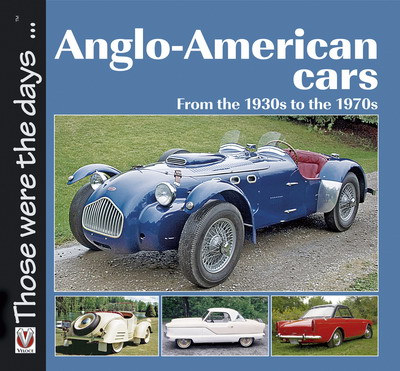Book Review: “Anglo-American Cars, From the 1930’s to the 1970’s”
/
Written by Norm Mort, Veloce Publishing, 2009, 96 Pages. ISBN: 978-1-845842-33-8
“Anglo-American Cars, From the 1930s to 1970s” is the latest book from Norm Mort from the “Those were the days…” book series by Veloce Publishing. The book is broken down by decade, and then alphabetically by manufacturer. “Anglo-American Cars …” presents a summary of each manufacturer, their principals, the cars they made, and the reason for their demise. The book is printed on heavy weight paper and features many interesting photos, most of which are in color.
Norm Mort was raised in Toronto Canada where his life was focused on cars from age 10. Norm has been accumulating photos & literature on Anglo-American manufacturers for almost 50 years, and much of that content was used in the creation of this book. Norm is also an Allard enthusiast, having restored a 1949 M type (chassis #M-1051). Several excellent photos by Norm’s son Andrew are also featured in this book
Not surprisingly, Allards feature prominently in over 25% of this book, but many other interesting manufacturers are outlined. They include Jensen, AC, Bristol, Jensen, Sunbeam, and TVR…along with lesser known companies like Atalanta, Batten, JBM, De Bruyne, and Trident. This book likely could have been much longer if it weren’t for the outset of WWII, which shuttered most of the small auto makers permanently. After reading the technical details and seeing photos of a Brough-Superior 6 or Railton Terraplane, one can only speculate what they might have been capable of if they had continued.
The common thread binding most of the cars through the 30’s to 50’s is the use of Ford V8 power and chassis components. It’s this feature, and close relationship with the Ford Motor Company that allowed Allard to be the only Anglo-American builder to make it through WWII. In the 50’s however, engines from other American auto makers started to make their way across the Atlantic and under the hoods of Bristols, De Bruyne’s, and Gordon-Keeble’s.
The final portion of the book highlights British automotive technology that made its way to America. With the success of the Austin Seven in Europe, it was assumed that the same would be true in America, but sadly the small car never caught on with Americans’ big car tastes. One well known American entrepreneur, Stanley Harold “Wacky” Arnolt II was impressed by the post-war British sports cars so much that he licensed the MG TD chassis & engine, and mated them with an Italian alloy-body. He did the same with a Bristol a few years later.
Overall, this book provides a very interesting read, and I suspect that it contains at least a few companies or cars that you never seen or heard of. The photography is first rate, and the brochures combine to give a helpful insight into each manufacturer. If you are an Allard enthusiast, you should pick this book up…not just for the Allard content. It helps one appreciate how lucky it was for the Allard Motor Company was to make it past WWII, and also helps us to speculate about what Allard could have been if they had not ceased vehicle production in 1959.
Click here to go to Veloce's web site for this book.
Click here to buy this book on Amazon.com.
Review by Colin Warnes

